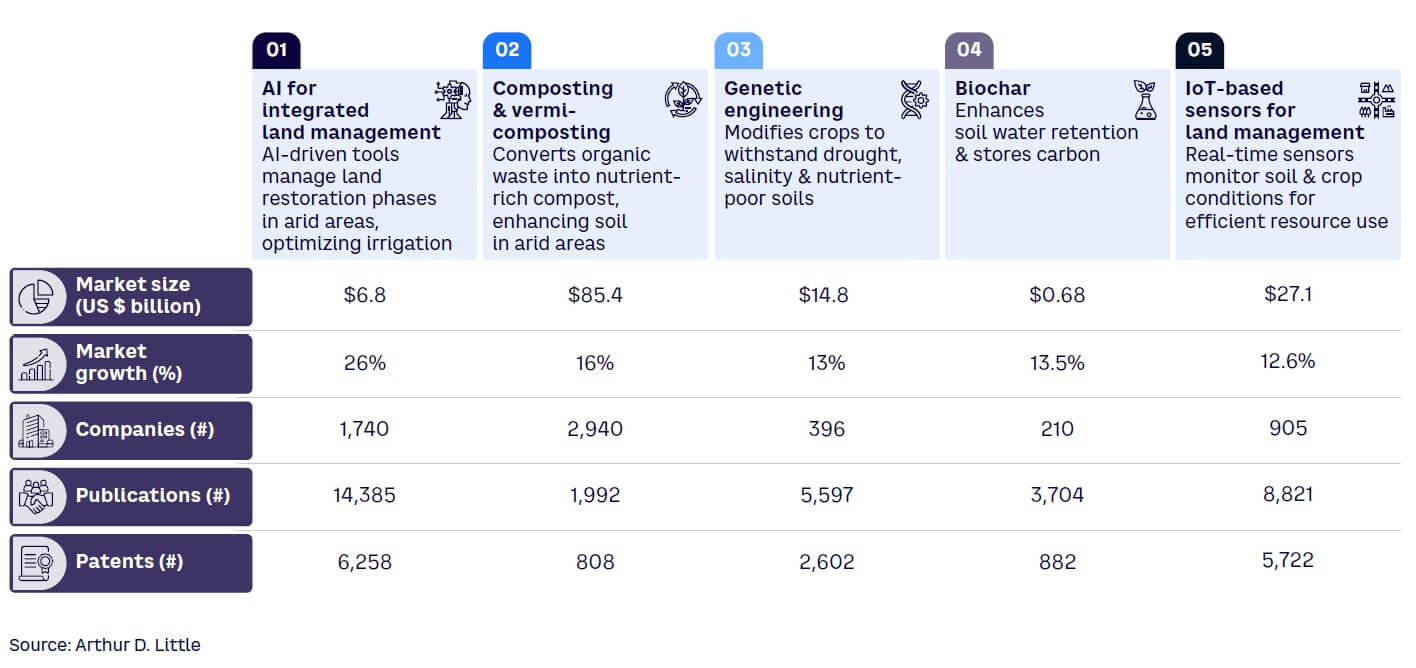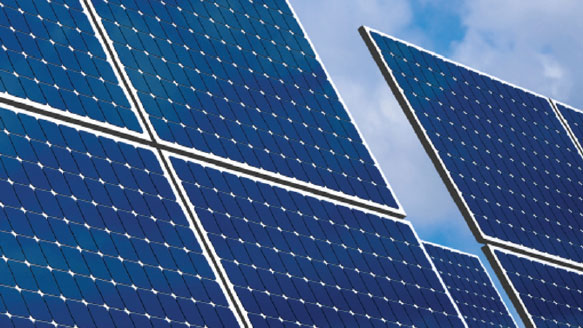
DOWNLOAD
DATE
Contact
Land degradation poses a real, increasing threat to global food and water security, biodiversity, and economic stability, with the arid and hyper-arid regions of the world facing the most acute challenges. To address this unfolding crisis, Arthur D. Little (ADL) created a robust, data-driven methodology to pinpoint technologies that can help “greenify” the Gulf Cooperation Council (GCC) and other arid areas in a targeted, sustainable way.
THE LAND DEGRADATION CRISIS
The world faces a looming crisis — land degradation that threatens global food and water security, biodiversity, and economic stability. To understand the scale of this challenge, we look to the United Nations Convention to Combat Desertification (UNCCD), which reports that between 2015 and 2019, an area twice the size of Greenland (100 million hectares) was degraded annually, directly impacting the lives of 1.3 billion people. This represents a significant portion of the world’s productive land: UNCCD estimates a total of 1.52 billion hectares (15.5% of reported land) counts as degraded, with economic losses projected to reach US $23 trillion by 2050.
Widespread tree-cover loss is exacerbating the crisis: the World Resources Institute (WRI) documented a decline of 488 million hectares since 2,000, equivalent to 12% of global tree cover at the turn of the century. Tree cover loss increased from 13.4 million hectares in 2001 to 28.3 million hectares in 2023.
The arid and hyper-arid regions of the world, including the GCC countries, are especially challenged. These regions are characterized by water scarcity and fragile ecosystems and are disproportionately vulnerable to land degradation and climate change impacts. Western Asia and North Africa are experiencing a degradation rate of 7.19%, underscoring the urgent need for innovative solutions, according to UNCCD.
This Viewpoint examines the potential for sustainable technologies to facilitate green cover growth in hyper-arid regions, with interventions ranging from AI-powered resource management and genetic engineering to the application of biochar and Internet of Things (IoT)−based sensors for land management.
FINDING A SOLUTION
ADL recently employed a robust, data-driven methodology to pinpoint the most promising technologies for sustainably greening arid regions. Recognizing the complexity of the fragile ecosystems in hyper-arid regions and the need for impactful solutions, we used the ADL Technology Foresight framework to analyze technology trends across diverse sectors. The framework guides a three-phase process: technology scouting, technology shortlisting, and technology evaluation (see Figure 1).

1. Technology scouting
We began by compiling a detailed list of more than 100 relevant technologies along the greening and land-management value chain. The list was developed via a thorough, AI-enabled literature review of leading academic papers, scientific journals, and industry publications. Next, sustainability and greening experts grouped the identified technologies into “families” to create a basis for a like-to-like analysis and provide a level of abstraction that balanced usefulness with complexity. This broad sweep considered cutting-edge technologies, such as genetic improvement, nanotechnology for targeted nutrient delivery, and sophisticated remote sensing techniques for precision land analysis. It included tried-and-tested methods that still have relevance for the sector.
2. Technology shortlisting
To refine the list, we employed a rigorous quantitative scoring system that focused on capturing insights from the market’s “pull” and the technology sector’s “push.” The latter aimed to reveal the trends for each technology, in terms of global coverage and enthusiasm from the innovator community, often reflected in the publications and patents landscape. For that, we used data from The Lens to create a comprehensive analysis of nearly 400,000 scientific publications and more than 300,000 patents across more than 170 countries. Multiple indicators were considered, including the 10-year issuance volume and the activeness ratio, which compares recent activity to the overall trend, providing insights into current innovation momentum.
Our push-side quantitative assessment was then enriched by a market-pull analysis. This involved consultations with experts to identify each technology’s alignment with the most pressing needs of the sector and its ability to help address critical climate and biodiversity challenges beyond greening, as follows:
- Climate change adaptation — managing climate change impacts on ecosystems and resources
- Biodiversity preservation — preventing biodiversity loss due to habitat destruction and other pressures
- Combating desertification — addressing soil erosion and the spread of deserts
- Sustainable water management — ensuring responsible water use while maintaining ecological balance
- Sustainable agriculture — balancing increased food production with environmental protection
- Invasive species management — controlling the spread of invasive species threatening native ecosystems
- Community engagement — involving local communities in developing and implementing sustainable practices
- Workforce capacity building — enhancing skills for implementing sustainable practices
- Environmental quality — mitigating environmental hazards for improved well-being
- Disaster risk reduction — minimizing the impact of natural disasters
- Environmental regulation — ensuring effective monitoring and enforcement of policies
- Sustainable investments — mobilizing investments for sustainable initiatives
AI data analysis and expert input resulted in a shortlist of 20 technology families that scored highly in terms of publications and patent registrations, with an average of more than 9,000 patent applications and 4,000 publications.
3. Technology evaluation
Guided by the principles of the ADL Technology Foresight framework, we dove deep into the global attractiveness of these technologies and considered factors crucial for successful implementation in hyper-arid regions. As part of that process, an in-depth trend analysis considered each technology’s market attractiveness, as represented by data from Tracxn on its current market size and projected growth, considering more than 15,000 companies in more than 150 countries. The team also considered the current innovation momentum, in terms of patents, publications, and number of new companies established in the domain.
To ensure the overall relevance of selected technologies to arid and hyper-arid regions, we identified five challenges specific to these regions: (1) climate change adaption, (2) biodiversity preservation, (3) combating desertification, (4) sustainable agriculture, and (5) invasive species management. We then estimated the strategic value of each technology. Local innovation momentum was considered by mapping the percentage of total patents that originated in our target geographies. This ensured that the selected technologies demonstrated high potential for both ecological impact and practical implementation in demanding environments.
5 KEY TECHNOLOGIES
Our comprehensive analysis identified five technologies that can revolutionize sustainable land-management practices in arid and hyper-arid landscapes (see Figure 2):
- AI for integrated land management. AI tools can optimize the lifecycle of land restoration and afforestation projects and are particularly helpful in hyper-arid environments. Unlike traditional reactive approaches, AI offers a proactive, data-driven methodology that leverages machine learning, geospatial modeling, and data analytics to inform key decisions. AI’s power lies in integrating and analyzing data from multiple sources (e.g., drones, light detection and ranging [LiDAR], remote sensing) for holistic insights.
- Composting and vermicomposting. Composting relies on microbial decomposition; vermicomposting uses earthworms to accelerate the process. Both create valuable compost that improves soil health, reduces the need for synthetic fertilizers, and promotes sustainable waste management. These techniques are not new, but they are relevant, given the effects of climate change and the harsh conditions of arid climates.
- Genetic engineering. Genetic engineering techniques, such as CRISPR-Cas9, offer powerful tools for modifying the genetic makeup of plants to enhance their resilience to the harsh conditions of hyper-arid environments. CRISPR allows precise and targeted gene editing, enabling researchers to introduce desirable traits like drought tolerance, salinity resistance, and improved nutrient utilization.
- Biochar. Biochar is a stable form of charcoal produced from the pyrolysis (heating in the absence of oxygen) of biomass such as agricultural waste, wood chips, or manure. Its porous structure and high surface area improve soil properties in hyper-arid environments. Biochar enhances water retention, nutrient availability, and soil aeration, promoting plant growth even in challenging conditions. It also sequesters carbon, contributing to climate change mitigation. Different feedstocks and conditions result in biochar with varying properties, allowing customization for specific soil and crop needs.
- IoT-based sensors for land management. IoT-based sensors offer a robust way to optimize land management in hyper-arid regions. These sensors monitor various parameters, including soil moisture, nutrient levels, salinity, weather conditions, plant health, and irrigation systems. By providing real-time data, they enable data-driven decision-making for precise irrigation, optimized resource use, and improved crop yields.
These technologies represent a significant advancement in our ability to combat desertification and restore degraded ecosystems and a crucial investment in a more sustainable and resilient future for vulnerable regions.

MAKE A COLLECTIVE IMPACT
The 16th session of the Conference of the Parties (COP16) of UNCCD, which takes place in Riyadh, Saudi Arabia, in December 2024, will allow the region to demonstrate leadership in pioneering innovative land-restoration strategies for hyper-arid environments. The Middle East Green Initiative (MGI) offers a regional framework designed to catalyze these efforts by providing a platform for coordinated action, resource mobilization, and knowledge sharing. MGI aims to facilitate the adoption and scaling of innovative solutions by fostering public-private partnerships, supporting R&D, and promoting regional cooperation. We advocate a multipronged approach that includes the creation of a regional framework for sustainable land management, investment in a regional green future, and leveraging existing regional and global initiatives for collective impact, as outlined below.
A regional framework for sustainable land management
- Incent regional solutions. Implement targeted financial incentives, such as carbon credits, tax breaks, and subsidies, to stimulate investment in sustainable land-management technologies. Simultaneously, prioritize biochar production from locally sourced date palm waste and other regional biomass, promote xeriscaping with native drought-resistant species, and integrate AI-powered irrigation systems optimized for regional climates.
- Develop regional regulatory best practices. Establish a regional regulatory framework that addresses the needs of each technology. This should include clear guidelines for responsible research, development, and deployment of genetically engineered halophytes and other plants adapted for arid environments, coupled with standardized quality-control measures for biochar and compost production using regional feedstocks.
- Preserve and promote GCC’s native flora. Prioritize the use of native drought-resistant plant species in landscaping and restoration projects throughout the region. Support local nurseries specializing in their propagation to ensure sufficient supply and preserve the region’s unique flora.
Invest in a regional green future
- Focus R&D on hyper-arid challenges. Direct funds toward collaborative research initiatives with regional and international partners, focused on adapting and optimizing technologies for the region’s specific challenges. This may include refining AI algorithms for regional climate data, exploring genetic engineering of native species for enhanced drought and salinity tolerance, and developing water-efficient composting techniques.
- Facilitate regional technology transfer. Establish a regional knowledge-sharing platform to connect researchers, practitioners, and policymakers. Facilitate access to open-source AI tools customized for the region, biochar production blueprints using local biomass, and genetic engineering protocols adapted for regional native species. Promote international collaborations to bring global expertise to the region while building local capacity.
- Invest in regional infrastructure. Promote strategic investments in infrastructure that support large-scale implementation. This includes developing decentralized composting facilities tailored to regional waste streams, establishing regional biochar production hubs using local biomass sources, and creating seed banks for native plant species.
Leverage existing regional & global initiatives for collective impact
- Maximize synergies between MGI and UNCCD. Leverage MGI’s regional framework and UNCCD’s global reach to promote collaborative efforts for sustainable land management. This includes aligning regional strategies with UNCCD’s goals, sharing best practices and lessons learned through both platforms, and exploring opportunities for joint programming and funding.
- Create public-private partnerships within existing and emerging frameworks. Encourage cross-sector collaboration through robust public-private partnerships. This includes joint ventures for AI-driven land-management solutions tailored to regional needs, collaborative research projects on biochar application in relevant crops, and private-sector engagement in composting initiatives. Partnerships should focus on both established and emerging frameworks to maximize their impact and foster innovation in sustainable land management.
- Empower local communities. Empower local stakeholders to become leaders in land-restoration efforts through training programs on sustainable land-management practices, local-international knowledge exchange, and promoting access to appropriate technologies. Support local ownership and long-term sustainability by facilitating access to resources and fostering inclusive partnerships focused on local needs.
Conclusion
THE PATH TO GREEN
By embracing our recommendations, the GCC can establish itself as a global leader in combating desertification and building a sustainable future for hyper-arid regions. First steps include:
- Establish a regional framework for sustainable land management aimed at rewarding solutions, developing regulatory best practices, and preserving the region’s native flora.
- Invest in a regional green future focused on R&D on hyper-arid challenges, regional technology transfer, and key infrastructure.
- Leverage existing regional and global initiatives for collective impact by forging public-private partnerships within existing and emerging frameworks and empowering local communities through inclusive partnerships.





